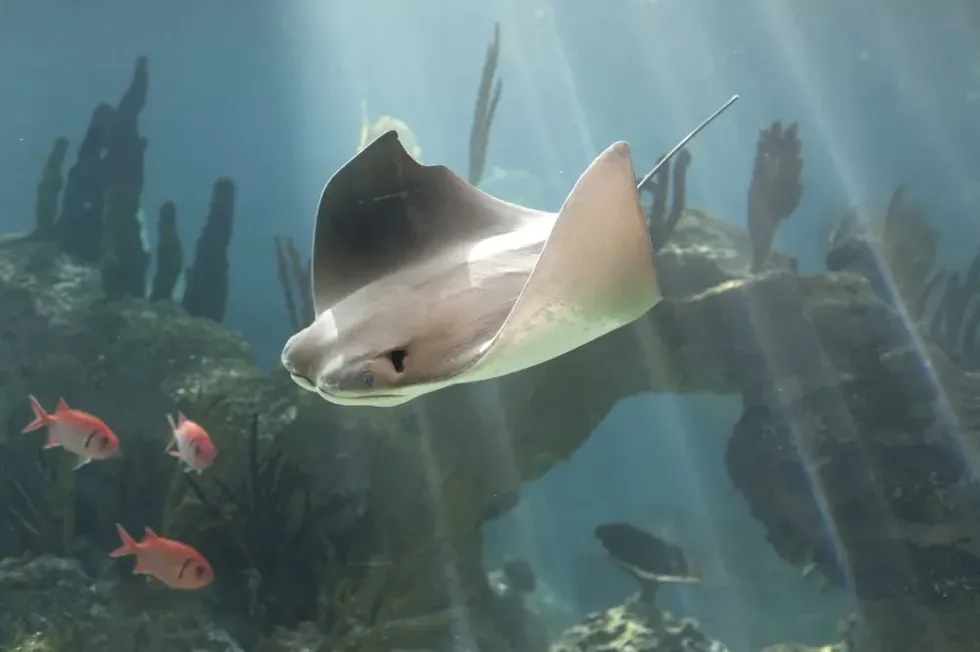Smooth skates are also known as New Zealand smooth skates. They naturally occur in the waters adjacent to New Zealand.
They are found in the water around the Snares, South and Stewart, and North Islands as well as in Chatham Rise. The smooth skate species mostly prefers coastal waters, soft seafloors, shorelines, and continental shelves.
Smooth skate fish exist up to depths of 3,937 ft (1,200 m) and they may live for as long as 24 years. Like other skits, they have kite-like bodies but lack the dermal denticles of rough skate fish, giving them their name.
Smooth skate fish are oviparous and they reproduce by laying eggs. Their diet consists of dead fish, small fish, crustaceans, shrimp, hakes, prawns, and codfish and themselves are prey to seals.
Their eggs are vulnerable to gastropods. Smooth skates are the largest of all skate fish and they are a Least Concern species according to the the IUCN.
For more relatable content, check out these eagle ray facts and stingray facts for kids.
Smooth Skate Interesting Facts
What type of animal is a smooth skate?
The smooth skate is a fish.
What class of animal does a smooth skate belong to?
The smooth skate belongs to the Chondrichthyes (cartilaginous fish) class of animals.
How many smooth skates are there in the world?
The exact number of smooth skate fish in the world is unknown since the population size is big and has not been properly estimated.
Where does a smooth skate live?
The smooth skate is native to New Zealand. This fish inhabits the coastal waters around the South, Stewart, and North Islands. The smooth skate species is also known to live on the shelf of the Snares Islands and in Chatham Rise.
What is a smooth skate habitat?
Smoooth skate fish like to inhabit coastal waters, the soft seafloors, continental shelves, shorelines, and upper shelf slopes. They prefer the continental shelf's mid-outer areas. They are rarely found below depths of 2,625 ft (800 m) but can exist up to 3,937 ft (1,200 m) below the sea surface.
Who does smooth skate live with?
Being skate fish, smooth skates may live a solitary life or sometimes with other skates.
How long does a smooth skate live?
Smooth skate fish may live to be 24 years old.
How do they reproduce?
Smooth skate fish are oviparous, meaning they reproduce by egg-laying. The young hatch from these eggs. Their fertility or fecundity is low and the generation time length is around 18 years.
What is their conservation status?
The conservation status of the smooth skate species according to the International Union for Conservation of Nature is Least Concern.
Smooth Skate Fun Facts
What does the smooth skate look like?
Males of the smooth skate species grow to have a pelvic length of 36.6 in (93 cm), which is the length from the snout to the pelvic fin's outer margin. The females are slightly larger with an average pelvic length of 44.1 in (112 cm).
Smooth skate fishes are the biggest of all skate species in the world. The upper side of the smooth skate is dark gray and has even darker gray or black spots.
The underside tends to be light gray or white in color. Some adult smooth skate fish have whiskers or prickles on their noses or snouts.
Smooth skate fishes are sometimes mistaken time and time again with rough skate fish, but smooth skates are bigger and lighter in color. There are no dorsal denticles, unlike other skate fish.
 * We've been unable to source an image of smooth skate and have used an image of blue-spotted stingray instead. If you are able to provide us with a royalty-free image of smooth skate, we would be happy to credit you. Please contact us at hello@kidadl.com.
* We've been unable to source an image of smooth skate and have used an image of blue-spotted stingray instead. If you are able to provide us with a royalty-free image of smooth skate, we would be happy to credit you. Please contact us at hello@kidadl.com.
How cute are they?
Smooth skate fishes are beautiful creatures. They have large flat bodies and long pectoral fins that seem to go on forever. They are graceful swimmers and they look like kites flying in the ocean kingdom. Their almost geometrical configuration has a way of being aesthetically pleasing.
How do they communicate?
Like other skate fish, smooth skates communicate through electrolocation. The electric signals that their organs produce signal different behavioral activities. Their organs are mechanoreceptors and can identify prey and predators through the movement of water. They can see through their eyes too.
How big is a smooth skate?
Smooth skates can grow up to 7.9 ft (2.4 m) long which makes them three times bigger than the closely related starry skates.
How fast can a smooth skate swim?
Being skate fishes, the smooth skate species can swim up to speeds of 1.5-2.5 body length per second.
How much does a smooth skate weigh?
The smooth skate fish species can weigh up to 154.3 lb (70 kg).
What are the male and female names of the species?
Males and females of the smooth skate species do not have specific names.
What would you call a baby smooth skate?
A baby smooth skate is called a juvenile or hatchling.
What do they eat?
Smooth skates eat dead fish, crustaceans, small fish, shrimp, prawns, hakes, and codfish.
Smooth skate fish themselves get preyed upon by species like seals and gastropods.
Are they dangerous?
No, smooth skates are not dangerous to humans. They do not have any stinging spines.
Would they make a good pet?
No, smooth skates would not make good pets. The fish of this species grow to be too massive to have as a pet.
Did you know...
Skate fish cannot sting humans since they do not have spines.
Skate fish do not have periods.
Skate fish and other related species breathe via 'spiracles' which are specialized organs that take in water, passing it through the gills and expelling it through gill slits. These 'spiracles' come in the form of slit-like openings close to the eyes.
Skates are cartilaginous fish.
Smooth skates are not common on any eating menu. This fish is too much a cartilaginous product to be commonly edible, but some establishments may serve it as a part of their menu in soups.
The thorny skate also belongs to the Rajidae family, like smooth skates. The thorny skate is native to the southeastern and North Atlantic Ocean. The thorny skate can be seen at depths of 66-3,281 ft (20-1,000 m). Also, the thorny skate species is classified Vulnerable by the IUCN.
The Malacoraja senta species of soft skate is also sometimes called a smooth skate. Leg skates of the Anacanthobatidae family of leg skates are also sometimes referred to as smooth skates.
How did smooth skates get their name?
Smooth skates do not have dorsal, tooth-like, thorny, and sharp denticles like other rays which is why they are called smooth skates.
Are smooth skates endangered?
No, smooth skates are not endangered. They are a Least Concern species according to the IUCN Red List.
In the future, we could see smooth skates coming under threat because of dangers like deep-sea mining. The number of smooth skates being caught as bycatch could also be underreported.
This is because they often get mistaken for rough skates. This means that the threat on smooth skates may not have been correctly estimated, since the habitat of smooth skates faces several threats.
Here at Kidadl, we have carefully created lots of interesting family-friendly animal facts for everyone to discover! Learn more about some other fish from our manta ray fun facts for kids and clearnose skate interesting facts pages.
You can even occupy yourself at home by coloring in one of our free printable blackbanded sunfish coloring pages.
* We've been unable to source an image of smooth skate and have used an image of common skate instead as the main image. If you are able to provide us with a royalty-free image of smooth skate, we would be happy to credit you. Please contact us at hello@kidadl.com.




 * We've been unable to source an image of smooth skate and have used an image of blue-spotted stingray instead. If you are able to provide us with a royalty-free image of smooth skate, we would be happy to credit you. Please contact us at hello@kidadl.com.
* We've been unable to source an image of smooth skate and have used an image of blue-spotted stingray instead. If you are able to provide us with a royalty-free image of smooth skate, we would be happy to credit you. Please contact us at hello@kidadl.com.
